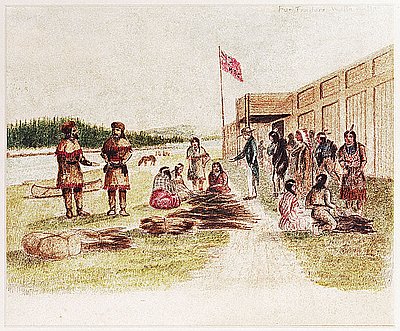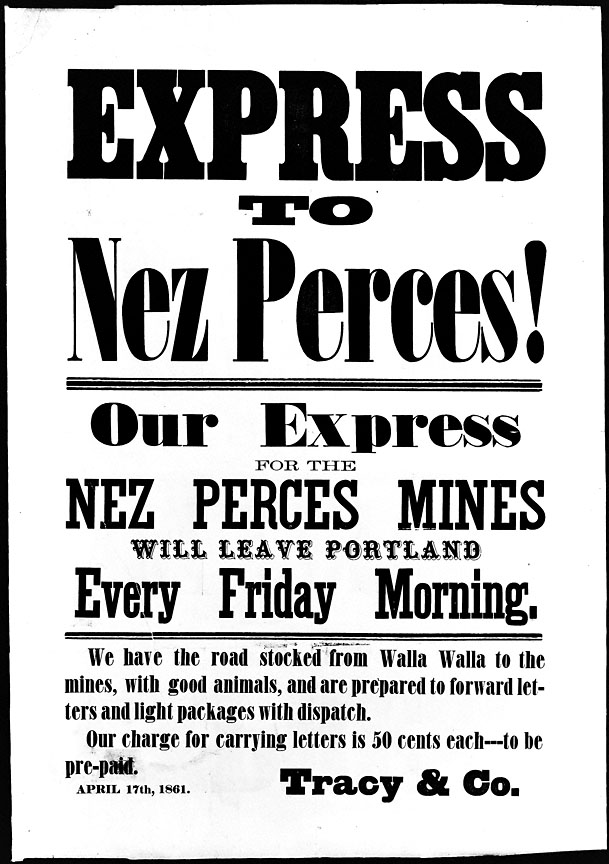- Catalog No. —
- Belknap 619
- Date —
- April 17, 1861
- Era —
- 1846-1880 (Treaties, Civil War, and Immigration)
- Themes —
- Environment and Natural Resources, Government, Law, and Politics, Native Americans, Oregon Trail and Resettlement, Trade, Business, Industry, and the Economy, Transportation and Communication
- Credits —
- Oregon Historical Society
- Regions —
- Northeast Oregon Trail
- Author —
- Unknown
Broadside, Express to Nez Perces!
This broadside was an advertising poster printed for the Portland-based stagecoach line Tracy & Co. Dated April 1861, it is one of the earliest advertisements for transportation to the gold mining area located in the traditional territory of the Nez Perce (Nimi’ ipuu) people.
The name “Nez Perce”—originally rendered in plural form as “Nez Perces”—was a term used by French-Canadian fur trappers to describe the Nimi’ ipuu people. Les Nez Percés translates as “the people with pierced noses.” Both the terms “Nez Perce” and “Nimi’ ipuu” are in use today. The traditional homeland of the Nez Perce encompassed parts of northeastern Oregon, southeastern Washington, and west-central Idaho. A Plateau group which had adopted aspects of the Plains horseman culture, the Nez Perce signed their first treaty with the U.S government in 1855. This treaty reserved much of their traditional territory and assured the Nez Perce protection from Euro American encroachment on their lands. However, by the early 1860s, circumstances took a dramatic turn. Following the mineral strikes in the American West the 1850s, prospectors sought new fields for mining, eventually turning their attention to the Nez Perce homelands. Over the spring and summer of 1860, a small group of prospectors based in Walla Walla, Washington, explored the Clearwater River and subsequently found gold. By the fall of 1860, news of the gold strike reached Portland, Puget Sound, and Northern California, and scores of prospective miners prepared to set out for the Nez Perce Reservation.
As thousands of miners began streaming into the Nez Perce Reservation in the spring of 1861, the possibility of armed conflict loomed in the background. For their part, Nez Perce leaders appealed to federal authorities to prevent Euro American incursions onto their treaty lands. However, both the Superintendent of Indians Affairs, Edward Geary and the highest-ranking military officer in the region, General Wright, concluded that public opinion would side with the miners rather than support military protection of the Nez Perce Reservation. As it was, the influx of thousands of miners into the reservation in the early 1860s caused hardships for the Indians. While some Nez Perce initially benefited from assisting and trading with the miners, many later became the victims of fraud, theft, physical assaults, and the loss of hunting grounds and natural resources. Perhaps the most marked injustice was the withdrawal of millions of dollars of gold from the reservation without compensation to the Nez Perce. As a direct result of the mineral strikes on the Clearwater River, and a later strike in Powder River Valley, the Nez Perce Reservation was reduced to a fraction of its original size in treaties signed in 1863 and 1868. These events led to a split between treaty and non-treaty Nez Perce—those leaders who had refused to sign the treaties. In 1877, Chief Joseph led a group of non-treaty Nez Perce who resisted Euro American settlement on their traditional lands in the Wallowa Valley of northeastern Oregon and refused to be relocated to the smaller Nez Perce Reservation in the territory of Idaho. The ensuing conflict became known as the Nez Perce War.
Further Reading:
Haines, Francis. The Nez Percés: Tribesmen of the Columbia Plateau. Norman, Okla., 1955.
Josephy, Alvin M. The Nez Perce Indians and the Opening of the Northwest. Boston, Mass., 1977.
Written by Malinda Jette, © Oregon Historical Society, 2003.
Related Historical Records
-
Fort Nez Perce
This drawing of fur trading at Fort Nez Perce (also known as Fort Walla Walla) was drawn by Joseph Drayton, one of several artists hired for a United …

-
Encounter with the Nez Perce
Lewis and Clark had entered the region of salmon and the people who relied on anadromous fish species to varying degrees for year-round sustenance. Unlike the buffalo-hunting tribes …
